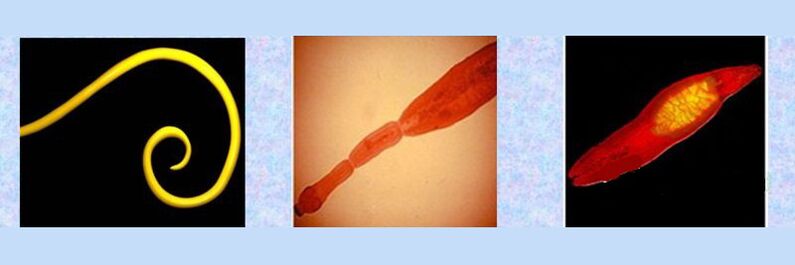There are many types of parasites that live in the human body, disrupting the functioning of internal organs and the entire body. People have known about helminths since ancient times, and for the first time they and the diseases associated with them were described by Hippocrates.
Today, science knows many types of parasites, but some of them are especially common in the human body. They differ in structure and way of existence, but to grow and reproduce, they need to enter the human body.
Based on the type of structure, all human parasites are divided into several types:
- roundworms;
- fluke;
- ice
Let's consider in more detail the listed types of parasites in the human body.
Characteristics of roundworms
These parasites are called nematodes. Outwardly, they resemble earthworms, but differ in their sharper heads. Their size varies from one millimeter to 130 centimeters.
Many nematode species have simple life cycles. After the human body is infected with roundworms, parasitic eggs will appear from the intestines, invisible to the naked eye.
When released into the environment, the eggs mature and then return to the human body through dirty food, water or dirty hands. Nematodes hatch from them and begin to actively develop.

All round parasites in the human body are divided into several subspecies, including:
- Pinworm. The most common parasites are easily transmitted between people through shared objects. The development of these nematodes in the body creates severe discomfort in the form of perianal itching.
- Roundworms. When massively infected, they pose a health hazard. They are worms up to 25 cm long. Once mature, the larvae spread throughout the body and internal organs in the blood.
- Trichinella. These small roundworms are up to 5 mm long. Developing in the intestines, they lay larvae. They then enter the blood vessels and spread throughout the body.
- threadworm. They are mainly distributed in hot countries and their carriers are insects.
Parasites - trematodes
The so-called trematodes are parasites in the human body, the symptoms of which are not always obvious. These are flatworms up to 8 cm long, with suckers on their bodies to feed on parasites.
Trematodes have a complex life cycle and change hosts many times. Eggs develop in water, then they enter the mollusk's body for metamorphosis. When modified larvae emerge from molluscs, they enter the bodies of crustaceans or fish, where they are transformed again.
Trematodes enter the final human host through raw or undercooked meat of carcinogenic species or fish.
Among the most common types of roundworms are:
- Opisthorchis. People become infected with these parasites by eating carp or carp that are lightly salted or undercooked.
- Chinese fluke. It affects many species of fish and crustaceans living in Primorye and the Sea of Japan. The parasite affects the bile and bile ducts, pancreas and liver.
- paragonimosis. It causes a dangerous disease that affects the lungs, liver, pancreas, kidneys and even the brain. People who eat undercooked crabs and crayfish from freshwater will become infected.
- Schistosomiasis. The parasite is often found in tropical countries, and the larvae actively penetrate human skin when swimming, as well as when water from ponds flows into the mouth.
Ice parasites (worms)
We have almost figured out what kind of parasites are in the human body, but there are still tapeworms, they are also of different types:
- Beef tapeworm. It can grow up to 10 meters long and humans become infected by eating low-temperature processed beef. Housewives are sometimes infected when checking the amount of spices or salt added to raw minced meat. After entering the body, the larvae turn into salt and pepper, stick to the intestinal wall and cause weight loss, loss of appetite, insomnia, and dizziness in humans.
- Pork tapeworm. It is smaller in size (up to 2 meters long) and can be infected by eating undercooked pork.
- Broad tapeworm. The length of this parasite varies from 6-15 meters. It is usually contracted by eating raw freshwater fish. Weakness, vomiting, nausea, abdominal pain and other symptoms occur.
- Echinococcus. A dangerous type of helminth that can be transmitted from cats and dogs that carry the parasite. In the human body, larvae emerge from eggs and are transported by blood to various organs, especially the liver. Echinococcal cysts then form, which are dangerous to health and require surgical intervention.
We have considered what parasites live in the human body, but these are not all known species of helminths. Research the symptoms of a parasitic infection and if you notice any, see your doctor for a diagnosis.






































